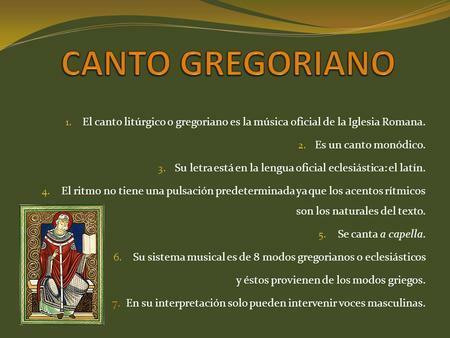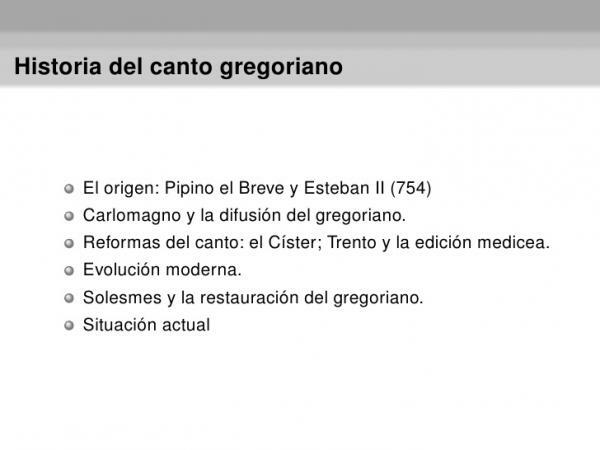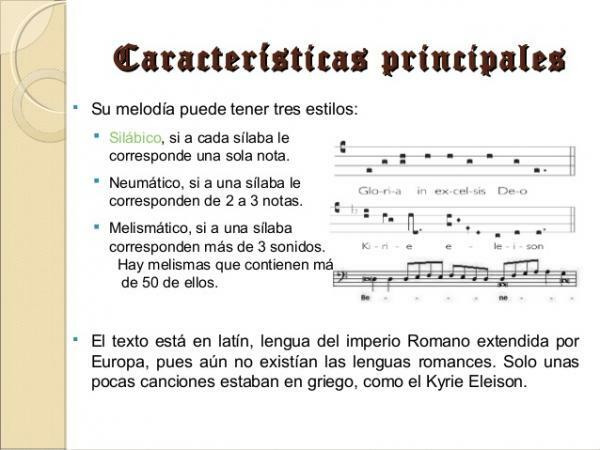GREGORIAN song: definition and characteristics

Image: Slideshare
As in many other things, the human being has taken something as natural as the voice and has turned it into an art. Over time he has been in charge of exploring the discipline of singing and taking it to all its imaginable variables, with different purposes and colors.
It is very interesting and important to know the origin of things, since it is in this way we can understand the why the way of being and functioning of the systems or concepts that we use every day, sometimes without notice us. When we think of ancient and historical song, a solemn “heavenly” song comes to us, in this article by a PROFESSOR, we will learn about the definition and characteristics ofl Gregorian singing.
If you hear mention of Gregorian chant and you think of a heavenly chant, with a lot of echo and rays of light coming through the stained glass windows of a church, you are quite close to getting the main idea right.
Gregorian chant is traditionally a simple, monodic song (that is, several people sing the same melody, in unison or with an octave difference)
and with a defined text. Sometimes it is called "plain song" and its main purpose was liturgical, meaning that it was used exclusively for religious ceremonies. For this same reason, and because it took place during Mass, the original language was Latin.Like the Gregorian chant is in principle a sentence, the text (many times taken from the Bible) is extremely important and the interpreters had to use their voice with humility to give it greater relevance. That is why this form of singing is solemn and did not claim any kind of prominence from those who performed it. More than the art of creation, the Gregorian chant it was an art of praise.

Image: Slideplayer
As we mentioned, Gregorian chant has a liturgical character. It was born as a form of prayer in Jewish synagogues and Christian communities. We are talking about a really old form of music, so much so that we do not have the necessary documents to know its exact date of origin. What we do know is that Christianity became the official state religion in 313, so at least we have a reference date where we can infer that it was used to accompany the mass.
Despite its early beginning, it was not until the 9th century that Gregorian chant began to be associated with the name by which we know it today, thanks to the Pope. Gregory the Great, who was in charge of compiling these songs that already existed. Gregorian chant it was used during massSome changed according to the feast celebrated or the liturgical season, others were repeated at all masses. The song accompanied each of the stages of the mass, during the entrance, the reading, the offerings, the communion, etc.
The changes in Gregorian chant were subtle and gradual. His time of maximum splendor was from the years 600-800. In the year 850 the first system of musical notation called "Pneuma" which was made up of a series of written signs to indicate to the singers the rhythm and the precise expression. Then, in the year 1050, what we know today as musical notes (do, re, mi, fa, sol, la, si) and also begins to experiment with polyphony (several melodic lines with voices instead of singing in unison).

Image: Slideshare
To finish this lesson, we will talk about the main characteristics of Gregorian chant so that we can better understand the essential elements of this type of chant. They are as follows:
- Song based on the religious text, in Latin.
- Use of the tetragram: Although we currently use the staff, at that time only 4 lines were used instead of 5.
- Monodic: a melodic line, I sing in unison.
- The melodic line moves by joint intervals, that is, close notes (second, third, fourth and fifth).
- Use of melismas. (When the note is changed staying on the syllable in the text).
- Each song is based on a certain musical scale.
- A cappella(does not have accompaniment with instruments)
- The works lack an author, they are anonymous.

Image: Slideshare
Gregorian chant has played a crucial role in the evolution of music because it has inherited determining factors such as writing, musical notes, their intervals and different major and minor scales, which are fundamental elements in the music theory that we know today in day.
The implementation of this western system of music has been changing by few but its essential principles come from the Gregorian chant, it is thanks to this sharing, to the need to leave in writing so that several people can interpret a single work the one that gives its greatness to the music. In other words, we can say that all the musical language that we currently know, we owe it to the Gregorian chant.

